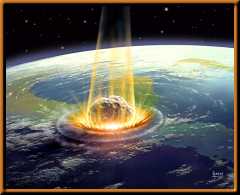UK Sees Opening of New Spaceguard Centre
Artist Makes an Impact
by Peter Wainwright
UK Sees Opening of New Spaceguard Centre
Artist Makes an Impact
by Peter Wainwright
| |
|
Press Release
29 September 2001 Situated amid beautiful countryside and sitting on the top of a hill near Knighton, mid-Wales, the Powys County Observatory was opened in 1995 as a private institution devoted to the Public Understanding of Science (PUS). Its main telescope is a 13-inch (34.5cm) apochromatic refractor with video feed, and there are two Schmidt-Cassegrains among others. The observatory contains possibly the largest Camera Obscura in the world -- certainly in Europe, and there is a small planetarium, a weather station with real-time satellite image downlink, and a computerised seismograph with real-time display.  But on 29 September a second opening ceremony was held: Sir Patrick Moore, CBE,,FRAS unveiled a plaque re-designating it as the Spaceguard Centre, under the direction of Jonathan (Jay) Tate. Spaceguard UK is dedicated to the promotion of the Spaceguard International programme, and active British participation in this project. Jay Tate has been largely responsible for the appointment of a governmental Task Force to investigate this problem, and among the many people attending the opening were its chairman, Mr Harry Atkinson and Mr Lembit Öpik, MP, a strong proponent of Spaceguard UK and grandson of Dr. E.J Öpik, famous astrophysicist, known for his discovery of what is now known as the Oort Cloud (of comets). Sir Patrick was welcomed by Mr Roger Bright, Mayor of Knighton,, applauded by a large crowd which included Andrew Thompson, owner of the observatory and Tate’s partner in this enterprise (and who arrived by helicopter), Mark Bailey, Director of Armagh Observatory, and Duncan Steel, author of books such as Target Earth. But on 29 September a second opening ceremony was held: Sir Patrick Moore, CBE,,FRAS unveiled a plaque re-designating it as the Spaceguard Centre, under the direction of Jonathan (Jay) Tate. Spaceguard UK is dedicated to the promotion of the Spaceguard International programme, and active British participation in this project. Jay Tate has been largely responsible for the appointment of a governmental Task Force to investigate this problem, and among the many people attending the opening were its chairman, Mr Harry Atkinson and Mr Lembit Öpik, MP, a strong proponent of Spaceguard UK and grandson of Dr. E.J Öpik, famous astrophysicist, known for his discovery of what is now known as the Oort Cloud (of comets). Sir Patrick was welcomed by Mr Roger Bright, Mayor of Knighton,, applauded by a large crowd which included Andrew Thompson, owner of the observatory and Tate’s partner in this enterprise (and who arrived by helicopter), Mark Bailey, Director of Armagh Observatory, and Duncan Steel, author of books such as Target Earth. The observatory is now open to the public, and to schools, for daytime or evening tours, but will now also be used to publicise the very real danger of an asteroid impact with Earth. There is currently no co-ordinated international effort to identify threatening Near Earth Objects (NEOs), or to deal with them once detected. An asteroid impact, such as the one which is believed to have wiped out the dinosaurs, or a comet such as Shoemaker-Levy 9 which hit Jupiter in 1994, could happen at any time -- which could be next year or thousands of years in the future -- and would devastate the Earth. It is hoped that the observatory will become part of a network giving as much as 30 or 40 years advance notice; time to develop some way of dealing with the threat. . .  A number of paintings and digital images of possible impacts and ways of diverting them, as well as photographs taken at the opening, may be found on the website of space artist David A. Hardy at www.astroart.org, and the Spaceguard website is here. The address is: The Spaceguard Centre, Llanshay Lane, Knighton, Powys LD7 1LW, telephone 01547 520 247. A number of paintings and digital images of possible impacts and ways of diverting them, as well as photographs taken at the opening, may be found on the website of space artist David A. Hardy at www.astroart.org, and the Spaceguard website is here. The address is: The Spaceguard Centre, Llanshay Lane, Knighton, Powys LD7 1LW, telephone 01547 520 247.Related articles and links: |
Source: Spaceguard UK, AstroArt.Org
Continue Reading: |
